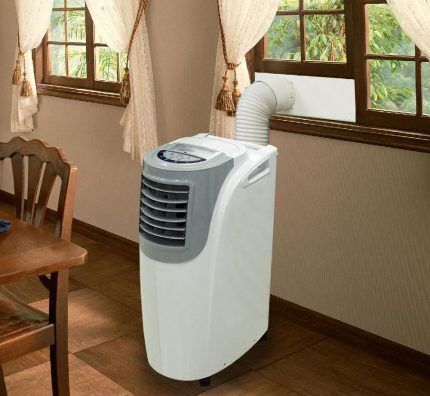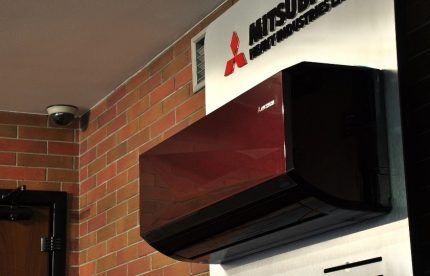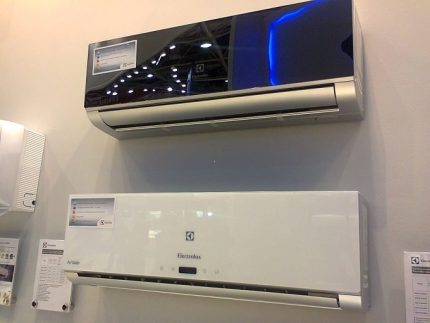How to choose an air conditioner for your home and apartment: varieties, manufacturers + selection tips
At times the summer heat becomes unbearable.At such moments, cooling climate control equipment, which maintains the most comfortable conditions for the residents in the room, is a great help, isn’t it?
Have you decided to buy climate control equipment, but don’t know how to choose an air conditioner so that it meets all the requirements?
We will show you how to cope with this task - the article discusses different types of air conditioners, their features and capabilities. An algorithm for calculating the required power is shown, and the subtleties and nuances of choice are highlighted. After all, you cannot act at random in such a matter: the quality of cooling directly depends on the correctly selected technical parameters.
We also reviewed the best manufacturers of this category of equipment. Before you go to the store, we suggest you study the useful photo and video information collected in this article.
The content of the article:
Types of climate control equipment for home
The first thing you need to decide on before purchasing is the type of air conditioner design.. This parameter must meet all the requirements and features of the room in which the device is planned to be installed.
There are two main groups of household climate control equipment – split systems and monoblock air conditioners.
Main types of split system designs
The most popular and common type of air conditioners are split systems. They are most often installed in apartments and houses.
The operating principle of the equipment is simple. The refrigerant, freon, moves through the formed closed circuit. With the help of mechanisms built into the blocks, it absorbs heat, transfers it to the environment, cools and releases cold air into the room.

In this case, the refrigerant alternately changes its physical state, passing from gas to liquid. In the case of heating operation, the cycle changes exactly the opposite.
The power component of the equipment is located in an outdoor street unit. It contains a compressor, fan and condenser that work directly to cool the air masses.
The indoor module is responsible for distributing cold air throughout the room and contains a control and monitoring system. Since the noisiest part of the equipment is taken outside, split systems operate quite quietly, without causing discomfort to household members.
The technology has numerous advantages:
- aesthetic appearance;
- compactness of the internal module;
- high efficiency, faster cooling due to high power;
- rational use of electricity;
- extended functionality.
There are also disadvantages. These include the rather high cost of split systems, difficult maintenance of the external part of the equipment when mounted on high floors, and the complexity of permanent installation, which excludes the possibility of seasonal moves.Professional installation is also not a cheap pleasure.
Split systems are divided into several subgroups that differ in design and method of installation of internal modules. Let's look at them in more detail.
Frame wall split systems Available in a variety of design options. Among them, you can choose the one that fits perfectly into your home interior.
Such blocks are relatively easy to install at the top of the wall, easy to operate and maintain, and are suitable for any residential premises.
Installation process cassette air conditioners much more difficult. The main part of the equipment is placed between the base and suspended ceiling covering; only the decorative grille remains outside.
The main advantage of the design is the uniform distribution of conditioned air flows in four directions.
Floor-ceiling type The device has two possible installation options: on the wall or ceiling. If you install it at the bottom of the wall like a convector, the air will be distributed vertically upward; if mounted on a ceiling, it will be distributed horizontally along the surface of the ceiling.
Unpopularity column air conditioners in everyday life is associated with their bulky dimensions, channel – with labor-intensive and painstaking installation, requiring preliminary design work for laying insulated air ducts.
The complexity of installing this type of device is justified only in huge private households with high ceilings.
There is another separate type of split systems - multi-split systemsdesigned to serve large houses and multi-room apartments. They are usually installed in buildings whose facades do not have space for several external units.

The equipment consists of a central outdoor unit and two or more indoor modules connected to it. Each of them can have different power and personal settings, but they all depend on the serviceability of the external module - if it fails, the system does not work.
Features of monoblock air conditioners
Monoblock equipment is extremely easy to install: it can be easily installed independently and, if necessary, moved between rooms, unlike split systems. It also attracts with its low price.
There are two types of monoblocks:
- Window.
- Mobile.
Window devices mounted in prepared holes in a thin wall or window opening, followed by sealing the resulting gaps. The rear of the structure faces the street.

When attaching window monoblocks, the thermal insulation of the building is often damaged, which leads to the free penetration of cold air into the rooms in winter. Due to the fact that the compressor unit is located directly in the room, the devices create a lot of noise.
Still, similar equipment is sometimes used for summer cottages. At the end of the summer season, it is removed and taken away for the winter, covering the installation opening with a special shield.
Mobile all-in-one PCs positioned as portable climate control equipment. Despite this, they take up a lot of space and cannot be called compact.

The devices are as noisy as window monoblocks. There is an unpleasant nuance in maintenance - during operation of the air conditioner, the owner must constantly monitor the collection tank, preventing excessive accumulation of condensate.
Again, mobile devices will be the best option for small country houses where there is no point in installing stationary systems.
TOP 5 leading equipment manufacturers
The second important question in choosing air conditioners for an apartment or house is the manufacturer of the equipment. Experts recommend trusting trusted brands that provide consumers with guarantees and provide quality service.
Below is the current rating of climate control equipment manufacturers in different price categories.
1st place – Daikin
The undisputed leader of the rating is the Japanese company Daikin, which has left its competitors one step behind. The company's specialists pay special attention to the technological content of the equipment. The possibility of a manufacturing defect is completely excluded.

Which Daikin air conditioner to choose for an apartment depends on your wishes in terms of functionality, power, and design of the internal module. The brand has a huge range.
Most models belong to the high price segment. Prices start from 30 thousand rubles and reach more than 200-300 thousand for cassette and floor-ceiling systems. Sometimes marks exceed the cost of similar competitive models by almost 4 times.
2nd place – Mitsubishi
Another Japanese premium brand, Mitsubishi, is following on the heels of its fellow countryman. The main advantage of its devices is multifunctionality.
Many options include an ionization air purification system, the ability to self-diagnose faults, several automatic modes, and a special anti-freezing mechanism for the outdoor unit.Users note silent operation and lack of vibration in air conditioners.

The company's product range covers all types of climate control equipment. Most modifications are presented in a high price category, but there are also more modest offers in the range of 25-30 thousand rubles.
3rd place – Toshiba
A place in the top five is deservedly occupied by another Japanese company, Toshiba, one of the first developers of split systems.
Its climate control equipment is a clear representative of the optimal ratio of quality and price. A suitable model of Toshiba split system can be purchased at a price of 17 thousand rubles.

Toshiba inverter models receive especially high user ratings. They have low noise levels, save up to 40% of electricity, and quickly reach the set temperature.
4th place – Electrolux
Like the previous participant in the rating, the Swedish brand Electrolux produces climate control equipment in the middle price segment. It is popular due to its affordable price, good quality, quite decent functional equipment and performance, and ease of maintenance.

The assortment includes household equipment of any complexity; there are monoblock models and split systems of various types of installation. Most of the offers are concentrated in the price range of 13-20 thousand rubles.
5th place – Ballu
The Chinese brand Ballu specializes in the production of all kinds of climate control equipment and is considered one of the best in the budget category.

The simplest wall-mounted split system of the brand can be purchased at a price of 11 thousand rubles, a mobile monoblock for a summer house - from 13 thousand. The cost of the company's economical inverter air conditioners starts from 17 thousand.
Selection of equipment according to technical parameters
The third determining parameter for choosing devices is their technical specifications. In this section of the article, we will discuss how to choose the right characteristics of an air conditioner, consider useful modes and functions that it can be equipped with.
Power calculation rules
When you decide on the appropriate type and manufacturer of climate control equipment, you will need to calculate the main technical parameter - the power of the device required for high-quality cooling. Its value depends on the area of the room where the air conditioner is supposed to be installed.
Errors in calculating performance parameters often lead to users buying a weak device that takes a long time to cool the air or does not fully cope with the assigned tasks.
Buying a more powerful air conditioner than you actually need is also useless: it’s an extra financial expense.
Cooling capacity is calculated individually. For average residential premises with ceilings whose height does not exceed 3 meters, this parameter is determined by dividing the total area by 10.
For every 10 squares there must be at least 1 kW. However, this calculated value is optimal for empty rooms. To obtain the correct final result, experts recommend adding to it the power of thermal radiation from people present in the room and household appliances.

A person, depending on activity, allocates an average of 0.1-0.3 kW, a computer - 0.3 kW, a TV - 0.2 kW. The approximate amount of heat generated from other types of equipment is calculated as 30% of the rated power.
In addition to these indicators, it is also worth taking into account the location of the windows and the level of sunlight.
The above algorithm boils down to the following formula:
Q = q1 + q2 + q3,
Where:
- q1 – performance for an empty room, taking into account external heat inflows;
- q2 – the amount of heat emitted by each person;
- q3 – the sum of heat coming from each unit of household appliances.
To count q1, you need to multiply the area of the room by the height of the ceiling surface, and then by the illumination coefficient (for shaded rooms - 30, medium - 35, well-lit - 40). The output number is divided by 1000.
If you do not want to delve into the intricacies of calculations and want to get a more accurate value, use a special online calculator. Based design power, equipment is selected in the range of -5% for the lower limit, +15% for the upper.
Important performance indicators
Cost-effectiveness, sound pressure level, the ability to smoothly maintain temperature, and installation parameters are also significant selection criteria.
The list of the most important operating indicators of an air conditioner includes:
- energy efficiency;
- noise level;
- compressor type;
- weight and dimensions.
The higher toenergy efficiency class, the more economical the device operates. The highest class is considered A+++. A++ is practically no different from it, and such devices often cost half as much.
It is better not to consider devices of classes B, C and D for apartments.

An operating system should not cause discomfort due to excessive noise. When choosing equipment, you should clarify the level of noise it produces, measured in decibels. The main thing is that it should not be higher than the established standards of 34 dB. The optimal value for home is less than 30 dB.
Air conditioners are equipped with a conventional or inverter compressor. Conventional models work on the principle of alternating temperature peaks. After reaching the specified levels, they turn off, and when the temperature returns to a certain threshold, they turn on.
Inverter devices cool the air faster: when turned on, they reach the desired mode at full strength, and then smoothly change the power, tracking temperature fluctuations.
Systems inverter type are aimed at continuous operation, but at the same time save a lot of energy and minimize harmful fluctuations in air temperature.
The intended installation location of the equipment should be correlated with the overall parameters of the modules. It is recommended to think through the nuances in advance: the permissible distance between blocks, location requirements, access to connecting communications.
Basic modes and additional functions
Most models of split systems and monoblock equipment are equipped with similar basic modes and additional options.
There are different basic and additional functionality of air conditioners:
- remote control – allows you to adjust operating parameters using the remote control;
- heating – warms up the air in the room in the off-season, but to operate in winter at an external temperature below -5 °C, the device must be equipped with a special kit that protects the outdoor unit from freezing;
- dehumidification/humidification – maintain optimal humidity balance;
- air cleaning – passes air through a system of filters that capture allergen particles and block odors;
- ventilation – distributes air evenly over the entire area;
- ionization – saturates the air with beneficial air ions that improve well-being and immunity;
- air flow control – allows you to select the preferred direction of cold/hot air;
- auto mode – independently selects a program to maintain a comfortable temperature;
- night mode – minimizes the noise of the device, smoothly reduces/increases the temperature by 1-3 °C;
- timer – sets the required time range for the device to operate.
Each additional feature is reflected in the price of the equipment. It is advisable to choose only those functions that are really useful in practice.There is no point in overpaying for unnecessary things.

Conclusions and useful video on the topic
General recommendations for choosing household climate control equipment:
Is it worth buying an air conditioner? Expert opinions on the main myths and misconceptions associated with this category of equipment:
The analysis showed that the best option for climate control equipment for apartments would be wall-mounted split systems. If you need a convenient, portable option for your garden, you should consider purchasing mobile air conditioners. Owners of large premises with an area of 50 m² or more with suspended ceilings are advised to take a closer look at cassette models.
When choosing a suitable model, take into account all the details and nuances outlined in the article. Useful information will help you make the right choice and purchase high-quality and reliable equipment that will meet your expectations and will delight you with long-term service.
What were you guided by when choosing an air conditioner for your own home? What factors were decisive for you when choosing? Which model of climate control equipment did you choose? Tell us about it in the comments section below the article.




What was the author based on when forming the rating of household air conditioners? Pulled from the ceiling? From what sources? If only this is an expensiveness rating? I myself recently bought a Galatec split system inexpensively. Of all those mentioned, I periodically see only Daikin in offices and apartments; everything is filled with Korean and little-known Chinese brands.
Good afternoon, Arthur. If you go around your high-rise building and rewrite the brands of air conditioners, you can make a rating of the preferences of the citizens of your building :) The all-Russian rating, I note, will be strikingly different from yours - the location of split systems by position characterizes the logistics features of your area (the proximity of China will be expressed by the predominance of their brands, the proximity of Japan will mean the dominance of their models), climate factor, average monthly salary.
Ratings are also compiled by sellers - I attached a screenshot showing the rating of split systems sold by Amazon, and added a rating for the Australian market. Naturally, there are no coincidences with the rating presented by our author - but I don’t see anything wrong with that.
When compiling ratings, our authors take into account not only “expensiveness”, but conduct a deep research of user ratings on several large review sites, compare functions and characteristics, and much more. Our ratings are independent - we do not receive any remuneration from manufacturers. Here's our latest rating of the best split systems on today's market, if you are interested in familiarizing yourself with the specific models recommended by our editors.
In addition to choosing the right model, do not forget about the correct use of the air conditioner. I know from my own experience that I could easily catch a cold myself. Avoid sudden temperature changes. It is optimal to set 24-26 degrees. Be sure to check that the air flow is not directed towards you. Many people mistakenly believe that this mode of use is correct. Nobody wants to be sick in the summer. Take care of your health.